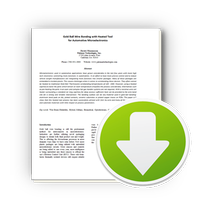Gold (Au) ball wire bonding is still the predominate method for interconnects in microelectronics. Industries are further utilizing novel packaging designs to shrink both final product size and weight. This is affecting the downstream processes in more dramatic ways than we have seen before. Now more plastic packages are being utilized with embedded microelectronic circuits.
Automotive Considerations
Microelectronics used in automotive applications have grown considerably in the last few years with more high tech electronics controlling more functions in automobiles. More sensors and controls are being added to cars every year and more intelligence is being embedded into these sensors to offload the car’s Electron Control Unit (ECU). These odd form-factor thermally isolated devices still require reliable wire bonding to complete the interconnections. In an effort to have more precise control and to reduce vehicle weight, manufacturers are integrating more functions into smaller packages. Many of these packages are embedded in molded plastic. This causes challenges when it comes to wire bonding these devices. They often cannot be heated to traditional gold ball thermosonic wire bonding temperatures of 120-150°C. However, using a heated capillary to bond the parts which remain at room temperature simplifies the process considerably. Alternatives such as pre-heating the parts in an oven and complex hot gas handler systems are not required. With a resistive wire coil heater surrounding a standard capillary (or long capillary for deep access), sufficient heat can be provided to the wire bond site for a strong and reliable interconnect. This allows the circuit designer the most flexibility to meet his desired goal with less consideration necessary to thermal issues related to the wire bonding process. The bonding surface can be any material used in gold ball bonding: aluminum bond pads on die, plated contacts, ceramic substrates or plated copper traces on PCBs. This heated tool process has been successfully utilized with 1mil Au wire and many of the standard die and substrate materials with little impact on process parameters.
heated capillary to bond the parts which remain at room temperature simplifies the process considerably. Alternatives such as pre-heating the parts in an oven and complex hot gas handler systems are not required. With a resistive wire coil heater surrounding a standard capillary (or long capillary for deep access), sufficient heat can be provided to the wire bond site for a strong and reliable interconnect. This allows the circuit designer the most flexibility to meet his desired goal with less consideration necessary to thermal issues related to the wire bonding process. The bonding surface can be any material used in gold ball bonding: aluminum bond pads on die, plated contacts, ceramic substrates or plated copper traces on PCBs. This heated tool process has been successfully utilized with 1mil Au wire and many of the standard die and substrate materials with little impact on process parameters.
Packaging in Plastic Housings
More applications have appeared in recent years requiring wire bonding parts that are already packaged in plastic housings that distort when subjected to the 120-150oC temperature typically required to perform reliable gold ball wire bonding. These applications may be processed utilizing a heated tool process to successfully bond wires that meet all quantitative wire bond quality measures applicable.

The wire passing through the heated capillary is bonded to the device using typical wire bond parameters (force, time and ultrasonic power) with a few milliseconds of delay after touchdown to allow the heat to transfer to the underlying material. This process works with die mounted on ceramic substrates as well as gold plated contacts embedded in the plastic. The plastic packages typically require deep access reach of the capillary.
Another use for this process is applications where the chip is thermally sensitive (such as thermal sensors–microbolometers) that could be damaged or change their characteristics if subjected to normal wire bonding temperatures.
Learn more:
Download the "Gold Ball Wire Bonding with Heated Tool for Automotive Microelectronics" technical paper.
----
David Rasmussen
Assembly Services General Manager
Palomar Technologies, Inc.
